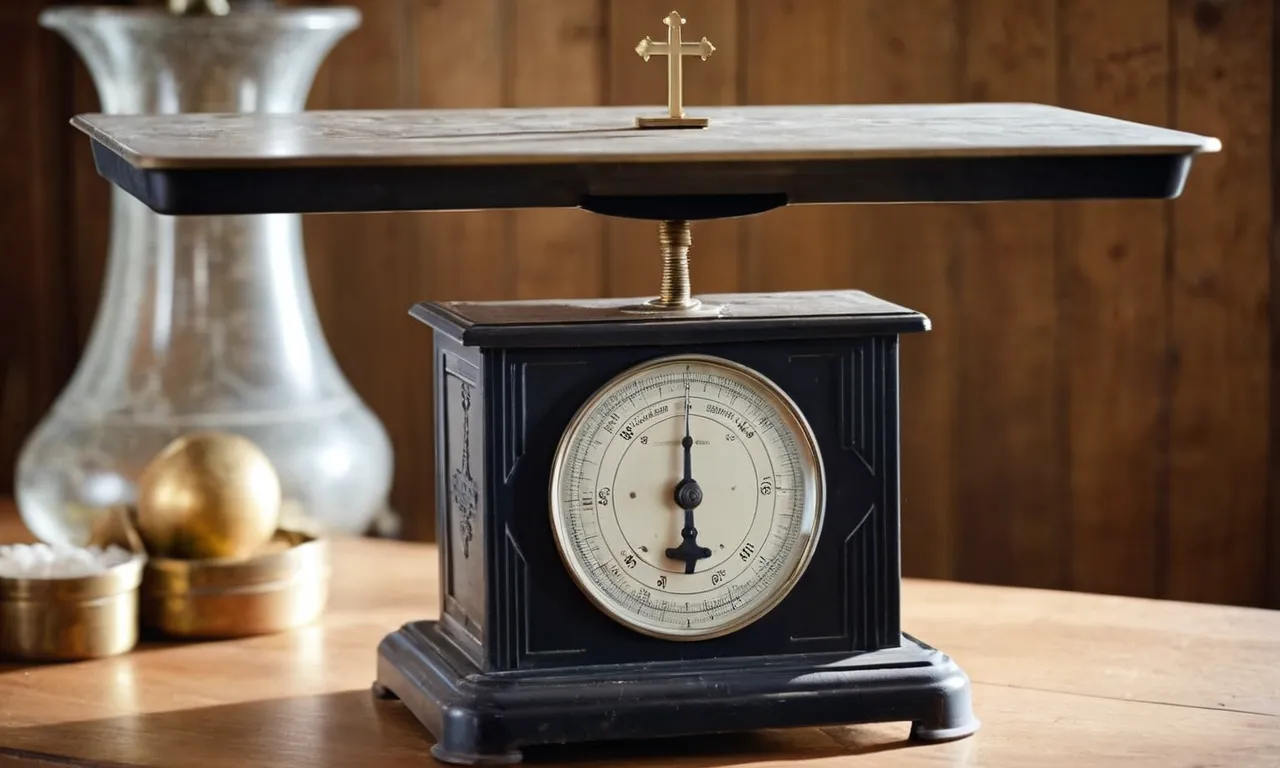How Much Did Jesus Weigh? A Thorough Investigation
The question of how much Jesus weighed during his time on earth is an intriguing one that many Christians ponder. After all, knowing details like Jesus’ height and weight makes him seem more tangibly real and human.
If you’re short on time, here’s a quick approximation: Based on typical builds of Middle Eastern Jewish men of his era, Jesus likely weighed between 110 and 130 pounds standing about 5 foot 5 inches tall.
In this comprehensive article, we will analyze biblical and historical evidence to estimate Jesus’ probable weight range. We’ll consider key factors like the average height and build of 1st-century Galilean Jewish men, typical diet and nutrition of the time, the rigors of Jesus’ itinerant, preaching lifestyle, as well as equity issues related to making assumptions about the Son of God’s human body.
Estimating Average Height and Build of Jesus’ Peers
Typical Height Range Based on Archaeology
Archaeological evidence gives us insight into the typical height range of people living in ancient Galilee during Jesus’ time. Excavated skeletal remains from first century burial sites indicate that the average height for men was around 5’1″ to 5’3″ (155 cm to 160 cm).
For example, analysis of skeletal remains from a first century CE burial cave in Jerusalem found the average height of men to be 159.1 cm or around 5’3″ (reference). Similar average heights have been found in other contemporary populations in the region as well.
Compared to today’s standards this seems quite short, but it was common for people living two millennia ago. Factors like childhood nutrition and disease likely played a role in limiting how tall people grew.
Diet and Nutrition in Ancient Galilee
The traditional Mediterranean diet and lifestyle of rural Galilee would have shaped Jesus and his disciples’ builds and health. People living off the land ate a mix of foods like whole grains, fruits, vegetables, olive oil, fish, eggs, dairy products which gave a fairly healthy diet.
Archeological remains suggest primary grains cultivated and consumed were barley and wheat. These were used to produce staples like bread and porridge. Grapes, olives, figs and dates provided important fruits.
Vegetables ranged depending on the season – lentils, beans, onions, garlic, cucumbers, melons and gourds.
Livestock grazing on the grassy hillsides produced milk, cheese, eggs and occasionally meat. Fishing the freshwater Sea of Galilee and Mediterranean Sea also supplied fish.
This well-rounded peasant fare of the ancient Galilean countryside likely produced average builds – somewhat short but sturdy, lean and muscular from the very physically active lifestyle. With Jesus and disciples often traveling by foot around the region, they were probably quite fit and used to covering long distances on dusty Middle Eastern roads.
The Physical Rigors of an Itinerant Preacher
Walking Miles Each Day
As an itinerant preacher without a home base, Jesus and his disciples spent most of their days walking on foot from one town to the next across the rural countryside and over rough terrain. Based on the locations of his journey noted in the Gospels, historians estimate Jesus likely walked about 3,125 miles total during his 3-year ministry.
That translates to Jesus averaging around 8-10 miles of walking per day. His longest single day trek mentioned in the Gospels was from Jericho to Bethany, a hike of over 20 miles up into the mountains near Jerusalem (John 11:18).
In addition, Jesus frequently went to remote wilderness areas and up into mountain ranges, vastly increasing the rigor of his miles on foot.
All this time on his feet surely kept Jesus in good physical shape with developed leg muscles and endurance. However, the many miles walking on uneven ground also put strain on his feet, ankles, knees and back.
As a comparison, studies show that modern soldiers carrying gear can suffer various overuse injuries walking just 4-8 miles daily.
Extended Fasting and Stress
In the Gospels, there are several references to Jesus fasting for an extended time such as 40 days (Matthew 4:2). Fasting for more than a day results in the body burning fat reserves for energy. This state speeds up muscle loss and deprivation of vital nutrients.
Studies show that after just 3 days without food, most people experience lethargy and mood shifts.
After his 40 day fast, Jesus was certainly very hungry, tired and physically drained when he was tempted by the devil in the wilderness. This account also reveals the extreme mental stress Jesus endured while fasting for spiritual reasons.
Self denial of earthly needs to focus on God was a regular part of Jesus’s ministry evident by his habit of retreating to pray alone, sometimes through the night.
In addition to his fasting, Jesus also maintained an ascetic lifestyle of voluntary poverty. He owned nothing, had no home and very few possessions. His itinerant living combined with lengthy travel by foot from place to place also added to both his physical and emotional stress.
So while Jesus avoided gluttony and likely maintained a lean physique from all his walking and fasting, he also endured weeks and months of strained resources and bodily deprivation in his daily ministry. Malnutrition and exhaustion probably took a toll at times.
But accounts of his compassion to heal others even when tired himself show Jesus’s profound spiritual strength and stamina that kept him moving forward.
Biblical Context on Stature and Appearance
Old Testament Prophecies
The Old Testament contains several prophecies about the Messiah’s physical appearance. Isaiah 53:2 states that the Messiah would grow up before the Lord like a “tender shoot” and would not have any stately form or majesty to attract people to him.
This suggests that Jesus was likely of average height and build, not particularly tall or muscular. Several other passages refer to the Messiah’s unimpressive appearance (Isaiah 52:14, Psalm 22:6-8). Yet being average and ordinary in stature allowed Jesus to be relatable and approachable to the common people he ministered to.
There are a few potential clues about Jesus’s height in the Old Testament. First Chronicles 11:23 refers to an Egyptian warrior of “great stature” whose height was five cubits. If a cubit was approximately 18 inches during Jesus’s time, this would make the man around 7 feet 6 inches tall.
Since a seven-foot-six man was of “great stature,” it’s likely Jesus was noticeably shorter than this. Additionally, the minimum height requirement for a Levitical priest was five feet three inches (Ezekiel 43:7).
Jesus came from a priestly lineage on his mother’s side, so he may have been at least this height but probably not much taller.
Was Jesus Unremarkable in Form?
In Isaiah 53:2, the prophet describes the coming Messiah as having “no stately form or majesty that we should look upon him, nor appearance that we should be attracted to him.” This suggests that Jesus likely did not stand out for his good looks or impressive stature.
He possessed an ordinary appearance that allowed him to minister anonymously until the time was right.
However, Jesus’s ordinary appearance does not mean he was homely or ugly in any way. In Psalm 45:2, the Messiah is described as “fairer than the sons of men,” which indicates he surpassed the average attractiveness of other men.
While seemingly plain compared to royal figures and military champions of the day, Jesus possessed a simple handsomeness that drew people to him without distracting from his message.
Some scholars believe Jesus had typical features of a first-century Galilean Semite—olive complexion, dark hair and eyes, and a beard following Jewish custom. His unattractive features may have been weathered skin and calloused hands from years of outdoor work.
Nevertheless, it was the beauty of Jesus’s compassionate character that transformed lives around him.
Theological Implications of Speculating on Divine Physiology
Attempting to apply human logic and physical attributes to a divine being is inherently problematic from a theological perspective. As an infinite, spiritual entity, God transcends human concepts of physiology and anatomy.
Furthermore, constructing detailed speculations about characteristics like Jesus’s weight or appearance risks reducing the Son of God to mundane mortal status.
However, thoughtful examination of biblical principles and teachings can still yield spiritual insights. As long as explorations into Jesus’s nature remain firmly grounded in scriptural truth, they may illuminate His selfless sacrifice and humanity’s relationship with the Divine.
The key lies in maintaining proper perspective – recognizing the limits of human intellect when contemplating holy mysteries.
In the end, while interesting to ponder, specifics like Jesus’s earthly weight matter far less than the weight of His message. Perhaps discussions would be better focused on the burdens He came to share and relieve rather than numbers on a scale.
As He Himself said, “Come to me, all you who labor and are heavy laden, and I will give you rest” (Matthew 11:28).
Conclusion
In the end, while it is fascinating to imagine details like Jesus’ height and weight, the Son of God clearly did not consider them important quantifiers. Beyond approximating his likely stature as similar to an average Galilean Jewish man of his day, obsessing over the numbers misses the deeper spiritual truth.
As Isaiah 53:2 suggests, the Messiah’s divine nature and loving character mattered far more to his ministry than external appearance.








